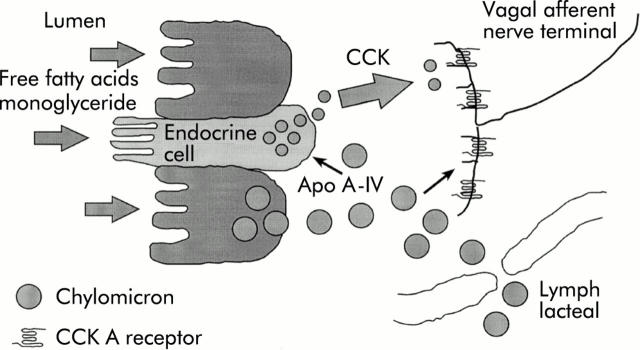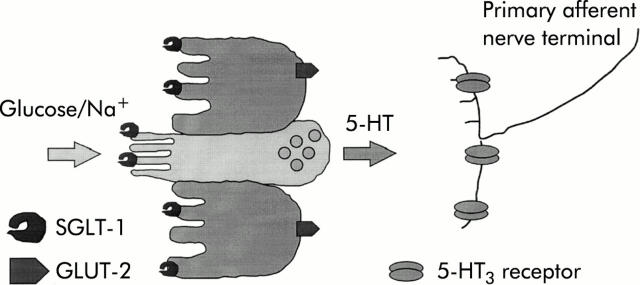Full Text
The Full Text of this article is available as a PDF (110.8 KB).
Figure 1 .
Diagrammatic representation of the effects of ingestion of free fatty acids on the visceral afferent nervous system. The chylomicron products are thought to signal to vagal afferent nerve terminals. Apo A-IV, apolipoprotein A-IV; CCK, cholecystokinin.
Figure 2 .
A working model showing how luminal hexoses signal to primary afferents. GLUT, glucose transporter; SGLT, sodium-glucose cotransporter; 5-HT, serotonin.
Selected References
These references are in PubMed. This may not be the complete list of references from this article.
- Berthoud H. R., Kressel M., Raybould H. E., Neuhuber W. L. Vagal sensors in the rat duodenal mucosa: distribution and structure as revealed by in vivo DiI-tracing. Anat Embryol (Berl) 1995 Mar;191(3):203–212. doi: 10.1007/BF00187819. [DOI] [PubMed] [Google Scholar]
- Berthoud H. R., Patterson L. M. Anatomical relationship between vagal afferent fibers and CCK-immunoreactive entero-endocrine cells in the rat small intestinal mucosa. Acta Anat (Basel) 1996;156(2):123–131. doi: 10.1159/000147837. [DOI] [PubMed] [Google Scholar]
- Blackshaw L. A., Grundy D. Effects of 5-hydroxytryptamine on discharge of vagal mucosal afferent fibres from the upper gastrointestinal tract of the ferret. J Auton Nerv Syst. 1993 Oct;45(1):41–50. doi: 10.1016/0165-1838(93)90360-7. [DOI] [PubMed] [Google Scholar]
- Buchan A. M. Nutrient Tasting and Signaling Mechanisms in the Gut III. Endocrine cell recognition of luminal nutrients. Am J Physiol. 1999 Dec;277(6 Pt 1):G1103–G1107. doi: 10.1152/ajpgi.1999.277.6.G1103. [DOI] [PubMed] [Google Scholar]
- Drapanas T., McDonald J. C., Stewart J. D. Serotonin Release Following Instillation of Hypertonic Glucose into the Proximal Intestine. Ann Surg. 1962 Oct;156(4):528–536. doi: 10.1097/00000658-196210000-00002. [DOI] [PMC free article] [PubMed] [Google Scholar]
- Fujimoto K., Cardelli J. A., Tso P. Increased apolipoprotein A-IV in rat mesenteric lymph after lipid meal acts as a physiological signal for satiation. Am J Physiol. 1992 Jun;262(6 Pt 1):G1002–G1006. doi: 10.1152/ajpgi.1992.262.6.G1002. [DOI] [PubMed] [Google Scholar]
- Fujimoto K., Fukagawa K., Sakata T., Tso P. Suppression of food intake by apolipoprotein A-IV is mediated through the central nervous system in rats. J Clin Invest. 1993 Apr;91(4):1830–1833. doi: 10.1172/JCI116395. [DOI] [PMC free article] [PubMed] [Google Scholar]
- Hayashi H., Nutting D. F., Fujimoto K., Cardelli J. A., Black D., Tso P. Transport of lipid and apolipoproteins A-I and A-IV in intestinal lymph of the rat. J Lipid Res. 1990 Sep;31(9):1613–1625. [PubMed] [Google Scholar]
- Hillsley K., Grundy D. Sensitivity to 5-hydroxytryptamine in different afferent subpopulations within mesenteric nerves supplying the rat jejunum. J Physiol. 1998 Jun 15;509(Pt 3):717–727. doi: 10.1111/j.1469-7793.1998.717bm.x. [DOI] [PMC free article] [PubMed] [Google Scholar]
- Hillsley K., Kirkup A. J., Grundy D. Direct and indirect actions of 5-hydroxytryptamine on the discharge of mesenteric afferent fibres innervating the rat jejunum. J Physiol. 1998 Jan 15;506(Pt 2):551–561. doi: 10.1111/j.1469-7793.1998.551bw.x. [DOI] [PMC free article] [PubMed] [Google Scholar]
- Hunt J. N., Knox M. T. Control of gastric emptying. Am J Dig Dis. 1968 Apr;13(4):372–375. doi: 10.1007/BF02233016. [DOI] [PubMed] [Google Scholar]
- Hölzer H. H., Turkelson C. M., Solomon T. E., Raybould H. E. Intestinal lipid inhibits gastric emptying via CCK and a vagal capsaicin-sensitive afferent pathway in rats. Am J Physiol. 1994 Oct;267(4 Pt 1):G625–G629. doi: 10.1152/ajpgi.1994.267.4.G625. [DOI] [PubMed] [Google Scholar]
- Isaacs P. E., Ladas S., Forgacs I. C., Dowling R. H., Ellam S. V., Adrian T. E., Bloom S. R. Comparison of effects of ingested medium- and long-chain triglyceride on gallbladder volume and release of cholecystokinin and other gut peptides. Dig Dis Sci. 1987 May;32(5):481–486. doi: 10.1007/BF01296030. [DOI] [PubMed] [Google Scholar]
- Kalogeris T. J., Fukagawa K., Tso P. Synthesis and lymphatic transport of intestinal apolipoprotein A-IV in response to graded doses of triglyceride. J Lipid Res. 1994 Jul;35(7):1141–1151. [PubMed] [Google Scholar]
- Kalogeris T. J., Monroe F., Demichele S. J., Tso P. Intestinal synthesis and lymphatic secretion of apolipoprotein A-IV vary with chain length of intestinally infused fatty acids in rats. J Nutr. 1996 Nov;126(11):2720–2729. doi: 10.1093/jn/126.11.2720. [DOI] [PubMed] [Google Scholar]
- Kim M., Cooke H. J., Javed N. H., Carey H. V., Christofi F., Raybould H. E. D-glucose releases 5-hydroxytryptamine from human BON cells as a model of enterochromaffin cells. Gastroenterology. 2001 Dec;121(6):1400–1406. doi: 10.1053/gast.2001.29567. [DOI] [PubMed] [Google Scholar]
- Li Y., Owyang C. Endogenous cholecystokinin stimulates pancreatic enzyme secretion via vagal afferent pathway in rats. Gastroenterology. 1994 Aug;107(2):525–531. doi: 10.1016/0016-5085(94)90180-5. [DOI] [PubMed] [Google Scholar]
- Lloyd K. C., Hölzer H. H., Zittel T. T., Raybould H. E. Duodenal lipid inhibits gastric acid secretion by vagal, capsaicin-sensitive afferent pathways in rats. Am J Physiol. 1993 Apr;264(4 Pt 1):G659–G663. doi: 10.1152/ajpgi.1993.264.4.G659. [DOI] [PubMed] [Google Scholar]
- McLaughlin J., Grazia Lucà M., Jones M. N., D'Amato M., Dockray G. J., Thompson D. G. Fatty acid chain length determines cholecystokinin secretion and effect on human gastric motility. Gastroenterology. 1999 Jan;116(1):46–53. doi: 10.1016/s0016-5085(99)70227-1. [DOI] [PubMed] [Google Scholar]
- Raybould H. E., Hölzer H. Dual capsaicin-sensitive afferent pathways mediate inhibition of gastric emptying in rat induced by intestinal carbohydrate. Neurosci Lett. 1992 Jul 20;141(2):236–238. doi: 10.1016/0304-3940(92)90902-j. [DOI] [PubMed] [Google Scholar]
- Raybould H. E., Lloyd K. C. Integration of postprandial function in the proximal gastrointestinal tract. Role of CCK and sensory pathways. Ann N Y Acad Sci. 1994 Mar 23;713:143–156. doi: 10.1111/j.1749-6632.1994.tb44061.x. [DOI] [PubMed] [Google Scholar]
- Raybould H. E., Meyer J. H., Tabrizi Y., Liddle R. A., Tso P. Inhibition of gastric emptying in response to intestinal lipid is dependent on chylomicron formation. Am J Physiol. 1998 Jun;274(6 Pt 2):R1834–R1838. doi: 10.1152/ajpregu.1998.274.6.R1834. [DOI] [PubMed] [Google Scholar]
- Raybould H. E., Zittel T. T. Inhibition of gastric motility induced by intestinal glucose in awake rats: role of Na(+)-glucose co-transporter. Neurogastroenterol Motil. 1995 Mar;7(1):9–14. doi: 10.1111/j.1365-2982.1995.tb00203.x. [DOI] [PubMed] [Google Scholar]
- Round A., Wallis D. I. The depolarizing action of 5-hydroxytryptamine on rabbit vagal afferent and sympathetic neurones in vitro and its selective blockade by ICS 205-930. Br J Pharmacol. 1986 Jun;88(2):485–494. doi: 10.1111/j.1476-5381.1986.tb10227.x. [DOI] [PMC free article] [PubMed] [Google Scholar]
- Tso P., Balint J. A. Formation and transport of chylomicrons by enterocytes to the lymphatics. Am J Physiol. 1986 Jun;250(6 Pt 1):G715–G726. doi: 10.1152/ajpgi.1986.250.6.G715. [DOI] [PubMed] [Google Scholar]
- Zhu J. X., Zhu X. Y., Owyang C., Li Y. Intestinal serotonin acts as a paracrine substance to mediate vagal signal transmission evoked by luminal factors in the rat. J Physiol. 2001 Feb 1;530(Pt 3):431–442. doi: 10.1111/j.1469-7793.2001.0431k.x. [DOI] [PMC free article] [PubMed] [Google Scholar]
- Zittel T. T., Rothenhöfer I., Meyer J. H., Raybould H. E. Small intestinal capsaicin-sensitive afferents mediate feedback inhibition of gastric emptying in rats. Am J Physiol. 1994 Dec;267(6 Pt 1):G1142–G1145. doi: 10.1152/ajpgi.1994.267.6.G1142. [DOI] [PubMed] [Google Scholar]




